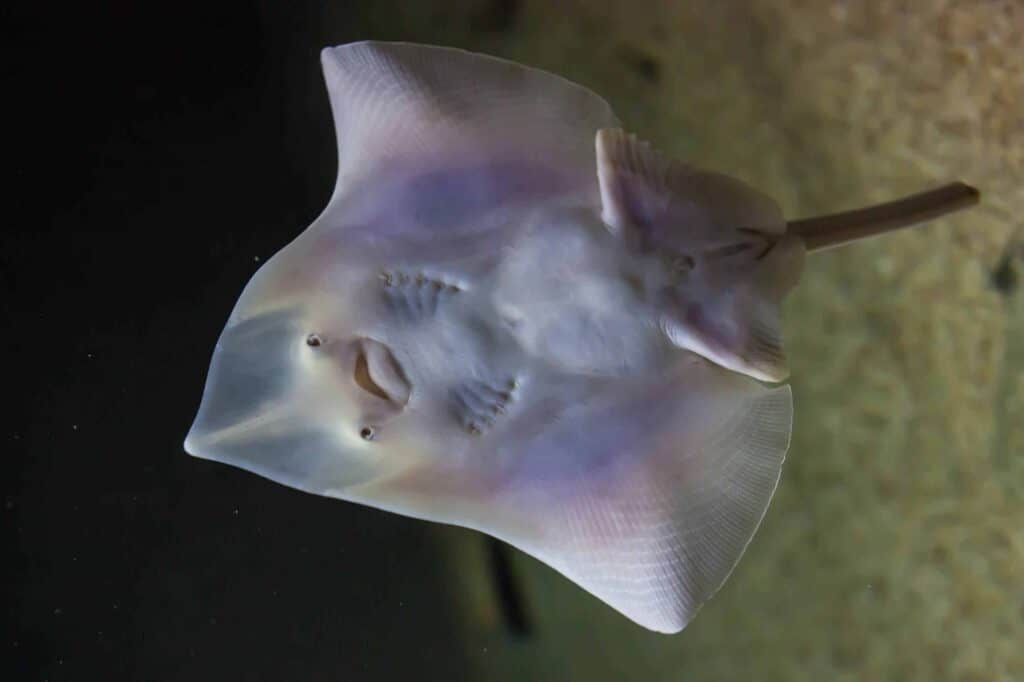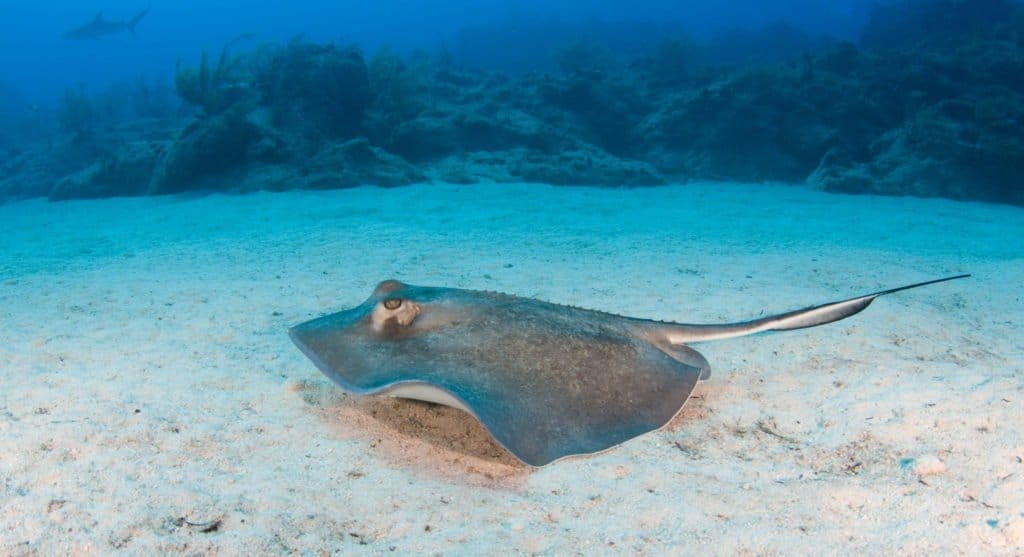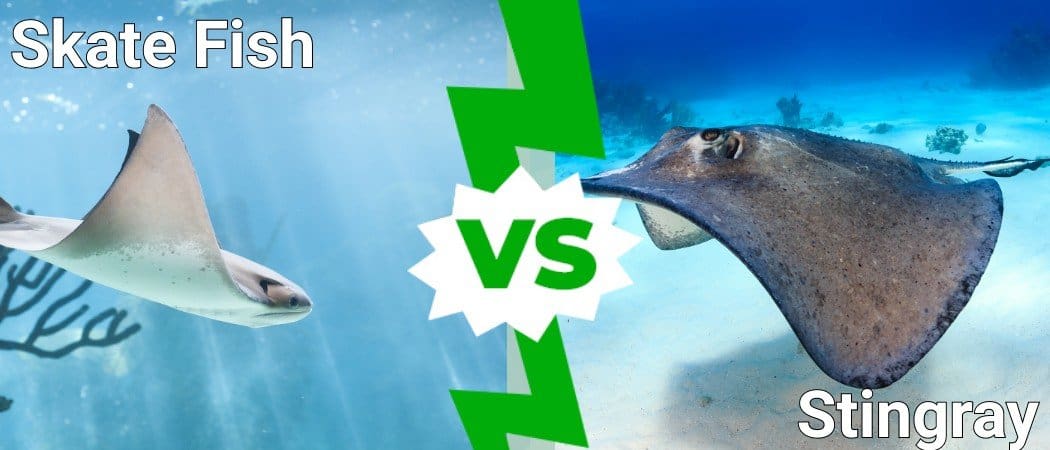Skate Fish
Their "mermaid pouches" can be found on beaches across the world!
Advertisement
Skate Fish Scientific Classification

Skate Fish Facts
- Prey
- Crustaceans, cephalopods, fish, mollusks
- Group Behavior
- Solitary
- Fun Fact
- Their "mermaid pouches" can be found on beaches across the world!
- Biggest Threat
- Ocean Trawling
- Most Distinctive Feature
- Flat body type that's similar to stringrays
- Gestation Period
- Eggs take 3 to 5 months to hatch depending on species
- Litter Size
- Up to 40 eggs
View all of the Skate Fish images!
The Skate fish are a family of animals with more than 200 species around the world.

Generally abundant across the world’s waters, skates are often caught as byproducts from trawlers, so some species are now critically endangered. Skates are also known for having meat that can match a scallop in consistency and flavor when prepared properly. In fact, many Michelin star restaurants now feature skate dishes on their menus.
3 Amazing Facts:
- One gigantic liver: The skate fish has one of the largest livers in the animal kingdom! Its liver accounts for a quarter of its body mass. In comparison, the human liver accounts for 2% of body mass! This large liver helps skate fish stay near the ocean floor.
- Thorn-like defense: While stingrays utilize a barbed tail for defense, the body of skates is made of a “thorn-like” material that helps defend them.
- “Mermaid pouches:” Unlike stingrays, which have live births, skates lay eggs. The pouches that contain these eggs are called “mermaid pouches.” It is not uncommon to find them washed up on beaches around the world!
Classification and Scientific Name

Skate fish have an evolutionary history that goes back over 400 million years.
©sh.el.photo/Shutterstock.com
Skate fish are cartilaginous fish that are part of the class Chondrichthyes, which also includes sharks, stingrays, and chimaeras. While fish in this class lack bones, and thus leave behind limited fossil evidence, it’s believed modern skates began evolving during the Jurassic Period (200 to 145 million years ago).
Over 400 million years ago, however, the first animals to leave the sea and begin walking on land were related to the skates, the last common ancestor of sharks and mammals. Genetic and brain studies show that skates have the makings of a walking animal, and they still “walk” on the ocean floor.
Skate fish belong to the Order Rajiformes, which contains more than 200 species spread across four families. These other families include smooth skates, softnose skates, and pygmy skates.
The largest skate fish family is Rajidae, which as of late 2020, contains 159 described species spread out across 16 genera. An example of a specific skate species’ scientific name would be the big skate, which is named Raja binocular.
Knowledge of skate taxonomy continues to grow. With these bottom-dwellers often living to depths of up to 8,900 feet, new species and genera may continue to be discovered in the years to come. In fact, during the past decade (2011 to 2020), six new species of skates were discovered!
Species
Most skate fish species have relatively narrow geographic regions. For example, there are eight different skate fish species that are endemic to the water surrounding New Zealand.
Some notable skate fish species include:

Skate fish are bottom-dwellers, so the depths of their habitats make it difficult to find and classify them, but it helps that they are region specific.
©A Cotton Photo/Shutterstock.com
- Big skate: Found from Baja California all the way into Alaska, the big skate is one of the largest species of skates and can reach 8 feet in length and 200 pounds.
- Deepsea skate: A species of skate that lives at the bottom of continental slopes and has been discovered living at depths reaching reaching 8,900 feet!
- Arctic skate: A skate with a wide geographic distribution that lives in cold waters off Greenland and the frigid waters off Antarctica.
- Common skate: contrary to its name, the common skate is now critically endangered.
Appearance
Skate fish species can possess extremely unique body shapes, colors, and even sizes! While big skate have reached 8 feet in length and weigh up to 200 pounds, most skate fish species measure less than 3 feet and weigh in at 10 pounds or less.
With approximately 200 species, skate fish appearance can vary dramatically. The most common color is a “brownish” tint that helps the species blend in with the bottom of the ocean; however certain skate species have dots or other markings. In addition, skates tend to have a “diamond” or even circular body shape.
Comparison to Stingrays

Skates and rays look very similar, but they have key differences that set them apart into different families.
- Eggs vs. live births: Skates produce eggs that they place in a protective pouch known as a “mermaid pouch” whereas ray species have live births of offspring.
- Different tails: Rays have sharp barbs at the end of their tails that are used for defense. Skate tails lack this barb, and they instead use “thorn-like” skin as their main defense against predators.
- Dorsal fins: Skates generally have either one or two dorsal fins (fins used for stabilization). Rays either lack dorsal fins or have small remnant fins.
- Size: Skates are generally smaller than rays. The largest ray species — the giant manta ray — can reach a wingspan of 29 feet and weight 3,600 pounds. Compare that to the largest skate species that weighs only about 200 pounds!
Beyond these differences, rays and skate fish also have key differences in their teeth and habitat (skates generally prefer living in deeper waters).
Distribution and Habitat
Skate fish are found in oceans across the globe. Different skate species inhabit environments that range from the shallow mouths of river deltas all the way to outer continental shelves that can reach 8,900 feet in depth.
Skates are found in both cold and temperate climates. Species can be found near the equator all the way to Antarctica in the Southern Hemisphere and Greenland in the Norther Hemisphere. As skate fish lay on ocean floors, they breath through spiracles which are positioned behind their eyes. These specially evolved openings allow skate fish to breath oxygenated water while buried in sand near the ocean floor.
Reproduction, Eggs, and Lifespan

Found on the beach, a mermaid pouch that protects skate eggs and baby skates from predators.
©Ginny Sturdy/Shutterstock.com
Skate fish reproduce with eggs that are placed in “mermaid pouches” that are made of collagen proteins and give skate eggs additional protection from predators on the bottom of the oceans. Skate embryos generally live in these pouches for about 3 months (12 weeks) before breaking free. Adolescents grow to about double the size of the pouch (generally about 4″ to 6″) by the time they’re ready to leave its protection.
As skates mostly live in deeper environments and are difficult to observe, it’s a challenge estimating their exact longevity. However, scientists have placed the common skate fish’s lifespan at 50 to 100 years. Other species may live for shorter periods. For example, estimates of the Winter skate lifespan are listed at about 20 years.
This long lifespan of some skate fish species means it can take 10 or more years to reach maturity, which can make repopulation challenging. Most skate species lay many eggs (common skates will lay approximately 40), but few of these eggs will lead to skate fish that reach maturity.
Conservation Status
Most species of skate fish are considered abundant, however trawling has led to a decrease in the estimated biomass of a number of skate species.
The common skate is now listed as critically endangered and is offered protections in the European Union. In the United States, the population of Thorny skates is declining, but in 2017 the fisheries service ruled it didn’t warrant protections under the Endangered Species Act. Although the species’ numbers are declining, the final report on its status noted Thorny skate populations are still estimated to number in the hundreds of millions.
In Cooking
Many skate fish species are abundant and often caught as a byproduct by trawlers. Traditionally, skate fish haven’t been cooked nearly as commonly as other fish species, but its use in cooking is growing.
One of the challenges of cooking skate fish is that, like other cartilaginous fish (like sharks), skates carry urea in their tissues. This can lead to an ammonia-like taste when not prepared properly. Most skates that carry this unpleasant odor are the result of poor storage and mishandling.
Skate is now found on the menu at Michelin-starred restaurants like New York City’s Le Bernardin. In addition, skate fish are seen as a delicacy in other cultures under different preparations. In South Korea, the city of Mokpo has become famous for its skate dishes that have a pungent odor from fermenting the fish.
View all 293 animals that start with SSkate Fish FAQs (Frequently Asked Questions)
What do skate fish eat?
Skate fish feed mostly on small invertebrates that live on the ocean floor. Their diet includes shrimp, crabs, fish, clams, and mollusks.
What are some skate fish recipes?
The top challenge to eating skate fish is getting meat that’s been handled properly and lacks an “ammonia-like” odor. If you can locate properly handled skate, its taste is often compared to scallops and is featured at several high-end restaurants. Skate fish are often served with brown butter or other sauces that pair well with fish.
What is a sea skate?
A sea skate is just another name for skate fish. They’re also called “skate wings” and other names. Importantly, a skate is not a ray, and the two families of fish have very notable differences.
Are skate fish endangered?
Most of the 200 species of skate fish are relatively abundant. Many species have suffered from biomass loss across the past 40 years due to trawling which often results in them being caught as a byproduct. The common skate is listed as critically endangered and has protections across the European Union.
What Kingdom do Skate Fish belong to?
Skate Fish belong to the Kingdom Animalia.
How do Skate Fish have babies?
Skate Fish lay eggs.
What is the difference between a skate fish and a stingray?
Even though both are cartilaginous fish, there are vital differences between a skate fish and a stingray. For a start, stingrays are dangerous while the other is relatively harmless. A skatefish tail is typically much thicker and shorter than a stingray’s tail. They also have different teeth and even reproduce and give birth in completely different ways. But that’s not all there is to learn about these fascinating fish.
What are the key differences between skates and manta rays?
The key differences between skates and manta rays are appearance, habitat, feeding habits, and reproduction.
Thank you for reading! Have some feedback for us? Contact the AZ Animals editorial team.
Sources
- Phys Org, Available here: https://phys.org/news/2017-02-thorny-skate-added-endangered-species.html
- Washington Post, Available here: https://www.washingtonpost.com/news/food/wp/2016/06/28/if-skate-wing-is-so-cheap-and-plentiful-and-popular-why-arent-we-eating-more-of-it/
- Fisheries New Zealand, Available here: https://docs.niwa.co.nz/library/public/NZAEBR-208.pdf
- Chef's Resources -- Skatefish, Available here: https://www.chefs-resources.com/seafood/finfish/skate-fish/
- Paxton, Eschmeyer, Et Al. (1970) Encyclopedia of Fishes
- Florida Museum , Available here: https://www.floridamuseum.ufl.edu/discover-fish/species-profiles/raja-binoculata/
- Shark Trust, Available here: https://www.sharktrust.org/pages/faqs/category/skates-rays
- Seattle Aquarium , Available here: https://www.seattleaquarium.org/animals/big-skate
















